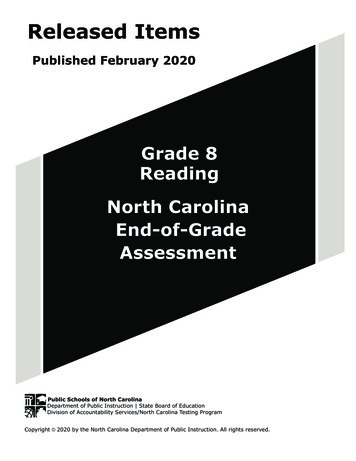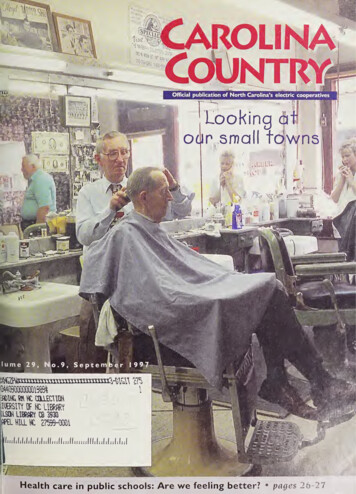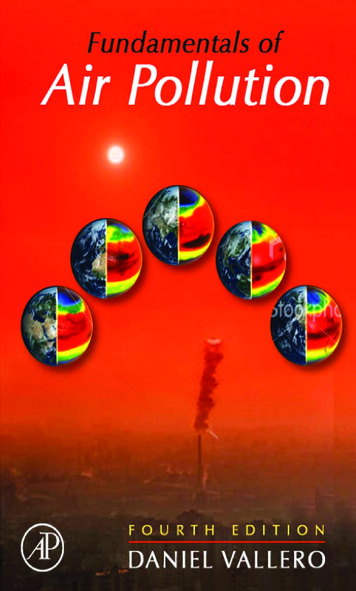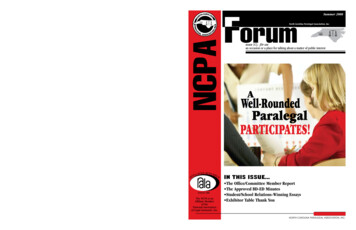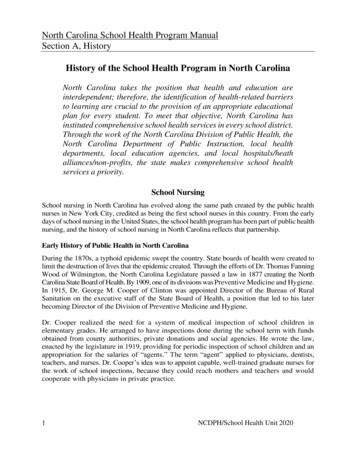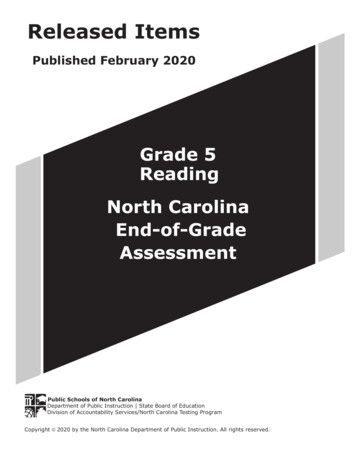
Transcription
Released ItemsPublished February 2020Grade 5ReadingNorth CarolinaEnd-of-GradeAssessmentPublic Schools of North CarolinaDepartment of Public Instruction State Board of EducationDivision of Accountability Services/North Carolina Testing ProgramCopyright ã 2020 by the North Carolina Department of Public Instruction. All rights reserved.
GRADE 5 READING—RELEASED ITEMSSample S2What does shy mean in the text?How many hearts does an octopus have?AoneBthreeCfiveDeightRS1DThe octopus is a sea animal. It has an interesting body. First, it has three hearts.The heart is often seen as a symbol of love. That’s a lot of love! An octopus also haseight limbs. Some people call them arms or tentacles. Eight arms could give a lot ofhugs, but the octopus is a very shy animal. If an octopus is scared, it will squirt inkand swim away.1
GRADE 5 READING—RELEASED ITEMSExcerpt from “Life without Gravity”by Robert ZimmermanBeing weightless in space seems so exciting. Astronauts bounce about from wall to wall,flying! They float, they weave, they do somersaults and acrobatics without effort. Heavyobjects can be lifted like feathers, and no one ever gets tired because nothing weighsanything. In fact, everything is fun, nothing is hard.SEDNOT! Since the first manned space missions in the 1960s, scientists have discoveredthat being weightless in space isn’t just flying around like Superman. Zero gravity isalien stuff. As space tourist Dennis Tito said when he visited the International SpaceStation, “Living in space is like having a different life, living in a different world.”EAWorse, weightlessness can sometimes be downright unpleasant. Your body gets upsetand confused. Your face puffs up, your nose gets stuffy, your back hurts, your stomachgets upset. If astronauts are to survive on the moon or a one-year journey to Mars—theshortest possible trip to the Red Planet—they will have to learn how to deal with thisweird environment.ELOur bodies are adapted to Earth’s gravity. Our muscles are strong in order to overcomegravity as we walk and run. Our inner ears use gravity to keep us upright. And becausegravity wants to pull all our blood down into our legs, our hearts are designed to pumphard to get blood up to our brains.RIn space, the much weaker gravity makes the human body change in many unexpectedways. In low gravity, your blood is rerouted, flowing from the legs, which become thinand sticklike, to the head, which swells up. The extra liquid in your head also makes youfeel like you’re hanging upside down or have a stuffed-up nose.The lack of gravity causes astronauts to “grow” between one and three inches taller.Their spines straighten out. The bones in the spine and the disks between them spreadapart and relax.But their bones also get thin and spongy. The body decides that if the muscles aren’tgoing to push and pull on the bones, it doesn’t need to lay down as much bone as itnormally does. Astronauts who have been in space for several months can lose10 percent or more of their bone tissue. If their bones got much weaker, the astronautswould snap once they returned to Earth.2Go to the next page.
GRADE 5 READING—RELEASED ITEMSAnd their muscles get weak and flabby. Floating about in space is too easy. If astronautsdon’t force themselves to exercise, their muscles become so feeble that when theyreturn to Earth they can’t even walk.Worst of all is how their stomachs feel. During the first few days in space, the innerear—which gives people their sense of balance—gets confused. Many astronauts becomenauseous. They lose their appetites.Weightlessness isn’t all bad, however. After about a week, people usually get used to it.Their stomachs settle down. Appetites return (though astronauts always say that foodtastes blander in space). The heart and spine adjust.EASEDThen, flying around like a bird becomes fun! Rooms suddenly seem much bigger. Lookaround you: The space above your head is pretty useless on Earth. You can’t get upthere to work, and anything you attach to the ceiling is simply something to bump yourhead on. In space, however, that area is useful. In fact, equipment can be installed onevery inch of every wall. In weightlessness, you choose to move up or down and left orright simply by pointing your head. If you turn yourself upside down, the ceilingbecomes the floor.ELAnd you can’t drop anything! As you work, you can let your tools float around you. Butyou’d better be organized and neat. If you don’t put things back where they belongwhen you are finished, tying them down securely, they will float away. Air currents willthen blow them into nooks and crannies, and it might take you days to find them again.RIn low gravity, you have to learn new ways to eat. Don’t try pouring a bowl ofcornflakes. Not only will the flakes float all over the place, the milk won’t pour. Instead,big balls of milk will form. You can drink these by taking big bites out of them, but you’dbetter finish them before they slam into a wall, splattering apart and covering everythingwith little tiny milk globules.Some meals on the space station are eaten with forks and knives, but scooping foodwith a spoon doesn’t work. If the food isn’t gooey enough to stick to the spoon, it willfloat away.3Go to the next page.
GRADE 5 READING—RELEASED ITEMSIt is easy to handle and makes the room seem bigger.BIt makes bones heavy and causes the head to swell.CIt is uncomfortable for the body and upsets the stomach.DIt reroutes the flow of blood and puts the heart in danger.DWhy does the author use the word NOT in paragraph 2?The author is trying to make sure the reader understands the point.BThe author is showing that some information is untrue.CThe author is using quotes from a space tourist.DThe author is disagreeing with the reader.SEAEA3AWhich statement summarizes the author’s view on weightlessness?A“In fact, everything is fun, nothing is hard.”B“ ‘Living in space is like having a different life, living in a different world.’ ”C“If you turn yourself upside down, the ceiling becomes the floor.”D“In low gravity, you have to learn new ways to eat.”EL2What are two main ideas about weightlessness in the text?R14Go to the next page.
GRADE 5 READING—RELEASED ITEMSpumping extra bloodBgoing the same wayCchanging the directionDhanging upside downThe bones stretch and bend easier.BThe bones break while in space.CThe bones become stronger.DThe bones become thin and spongy.SEADHow does the lack of gravity in space affect the bones?EA6AHow might astronauts in space prepare for the return to Earth?Aby performing somersaults and flying aroundBby learning how to care for themselves when feeling sickCby doing exercises to strengthen bones and musclesDby growing taller and getting flabbyEL5What is the meaning of the word rerouted in paragraph 5?R45Go to the next page.
GRADE 5 READING—RELEASED ITEMSAouter spaceBsmall placesCon the ceilingDout in the openDWhich statement summarizes the text?After adjusting, the astronauts enjoy some of the benefits of weightlessness.BAt first, many astronauts find weightlessness to be fun and easy.CUsually, astronauts take a one-year trip to Mars.DIn space, astronauts’ bodies have to adapt to Earth’s gravity.EASEAEL8What is meant by the phrase “nooks and crannies” in paragraph 12?R76Go to the next page.
GRADE 5 READING—RELEASED ITEMSMaking the World’s Rarest Syrupby David EdwardsIt’s six in the morning and already hot. In just a few hours, the thermometer willregister over a hundred degrees. My family has come to Southern Arizona’s ColossalCave Mountain Park to participate in something few tourists experience—the annualsaguaro-cactus harvest. For a single day each year, Colossal Cave Mountain Park hosts aTohono O’odham saguaro harvest. Any other time of year, it’s illegal to harvest saguarofruit here.DMature saguaros stand fifteen feet and higher, and the fruit we’ll be gathering grows ontop of their spine-covered arms and trunks. The obvious question: How will we reachthem?EASEHere to answer this question—and more—are Regina (Gina) Siquieros; her sister,Angie Saraficio; and Regina’s 16-year-old grandson, Gustavo Verdugo. They areTohono O’odham. The Tohono O’odham (Desert People) were once called PapagoIndians by nonnatives. They make up the second largest Native-American nation inthe United States.RELGina begins by showing us how to make our kukuipad—harvesting sticks—from saguaroribs. The wooden ribs are straight, unlike most plants growing in the Sonoran Desert,and light, but none of them is long enough to reach the fruit. We bind the ribs togetherusing pliers and bailing wire, positioning the thickest, heaviest rib on the bottom. Weattach a small creosote branch crosswise near the top of our harvesting sticks. Creosoteis very strong and won’t easily break when pulled or pushed, which is how we will bringdown the fruit.Saguaro fruit is about the size and shape of a large egg and covered with areddish-green peel. Beneath the peel, the fruit is bright red and freckled with as manyas two thousand tiny black seeds. The fruit feels like a fresh fig in your mouth, buttastes more like watermelon mixed with pear.Gina explains that the first fruit we gather is very special. . . . it will take a lot ofpatience to make syrup from the fruit we’ll gather.7Go to the next page.
GRADE 5 READING—RELEASED ITEMSAs we nudge the saguaro fruit loose, I stop and listen. The falling fruit sounds almostlike rain—a soft thump when the fruit lands in the dirt or a sharp patter when it’s caughtin the buckets.When the first fruit is taken from each saguaro, we leave the peel red-side up at thebase of the saguaro, open like a flower. Gina says this will help summon the summerrains.SEDWe use our thumbs to scoop the fruit into our buckets, careful to avoid the spines thatoccasionally cling to the bottom of the peel. Soon, my hands are sticky and flecked withcrunchy black seeds.EAGina and Angie add a little water to the fruit we’ve collected and pour it into a large potto boil for several hours. After the fruit has boiled, Gina brings out a square cloth tostrain the mixture. Then she returns the hot juice to the cleaned pot to boil a secondtime.ELIt’s nearly sunrise before the saguaro syrup is ready, but everyone agrees it was worththe wait. A tiny four-ounce bottle of “the world’s rarest syrup” sells for 25. Now that Ihave experienced the hard work that goes into making it, I understand why it is soexpensive.RWe leave with a small jar filled with this rare syrup and lasting memories of theopportunity to learn from the Tohono O’odham.8Go to the next page.
GRADE 5 READING—RELEASED ITEMS11Saguaro fruit are peeled using saguaro ribs and creosote branches.BKukuipads are created with saguaro ribs and creosote branches.CFruit from creosote branches and saguaro ribs are used to make the syrup.DSaguaro ribs and creosote branches are ingredients needed to create thesyrup.DASEBased on paragraphs 4 and 5, why are creosote branches used at the top ofa kukuipad?Creosote branches are straight and light, making it easy to spear fruit at thetop of a saguaro cactus.BCreosote branches are thick and heavy, making it easy to push fruit from thetop of a saguaro cactus.CCreosote branches are bright red and freckled, making it easy to see them atthe top of a saguaro cactus.DCreosote branches are sturdy and durable, making it easy to prod fruit fromthe top of a saguaro cactus.EAAEL10Which statement explains why saguaro ribs and creosote branches are importantfor creating saguaro syrup?R9Which detail reveals how the Tohono O’odham feel about the land?AGina shows the harvesters how to make kukuipad.BGina and Angie add water to the saguaro fruit and boil it.CGina tells the harvesters to leave the first fruit at the base of the saguaro.DGina brings a square cloth to strain the syrup before boiling it again.9Go to the next page.
GRADE 5 READING—RELEASED ITEMSbring forthBsend awayCcatchDstopDWhich step comes after placing the peel at the base of the saguaro?Bring out a square cloth to strain the mixture.BReturn the hot juice to the cleaned pot to boil a second time.CScoop the fruit into buckets and avoid the spines that cling to the peel.DNudge the saguaro fruit loose and put into buckets.SEAEA14AWhat does the word flecked mean in paragraph 9?AstripedBdottedCdisguisedDwrappedEL13What does the word summon mean in paragraph 8?R1210Go to the next page.
GRADE 5 READING—RELEASED ITEMSApass through a filterBinjure a body partCpainful effortDmake great demandsDHow are the harvesting of saguaro fruit and the creation of saguaro syrup similar?Both require creosote branches and boiling water to reach the desired result.BBoth require inexperience and good fortune to reach the desired result.CBoth require kukuipads and large pots to reach the desired result.DBoth require patience and persistence to reach the desired result.EASEAEL16What is the meaning of strain as it is used in paragraph 10?R1511Go to the next page.
GRADE 5 READING—RELEASED ITEMSThe World in a Bottleby Janeen R. AdilIf you want a garden full of plants, you need to grow them outdoors. Or do you? What ifyou could bring the world indoors—on a smaller scale, of course! What if you could haveyour own collection of living plants right inside your home? All you have to do is create aworld in a bottle by making a terrarium.DA terrarium is a clear glass or plastic container holding natural materials such as dirt,sand, and rocks. It gets its name from the Latin word for earth, which is terra. Terrariumsare typically used for growing small plants.SEA terrarium is actually a little ecosystem. Because the container is usually closed, it actslike a tiny greenhouse. Plants take up water from the soil and release it into the air. Asthe water vapor cools, it condenses on the sides of the glass and trickles back into thesoil. Then the process starts all over again.ELEADuring the day, plants use carbon dioxide inside the terrarium for photosynthesis,providing energy for their growth. Oxygen and water vapor are released into the air.Then, at night, the plants use the oxygen and give off carbon dioxide, and the cyclestarts all over again.RWhile ancient Greeks are credited with being the first to grow plants in transparentcontainers, a nineteenth-century London physician was the creator of the modern-dayterrarium. Dr. Nathaniel Ward was conducting an experiment that led to the terrarium’saccidental discovery.Dr. Ward wanted to study how a sphinx moth developed, so he buried a pupa in somemoist earth in a closed glass container. As time passed, he was surprised to see that afern seedling and some grass had sprouted in the jar. Dr. Ward decided to continue theexperiment, this time focusing on the plants. He kept the jar sealed, never adding evena drop of water, and for four years the plants grew and thrived.Dr. Ward called his tiny greenhouse a fern case. After experimenting with other plantsas well, he wrote up his findings in the book On the Growth of Plants in Closely GlazedCases, published in 1842. His work led to the creation of more spacious, enclosed glasscontainers called Wardian cases, which were larger versions of today’s terrariums.12Go to the next page.
GRADE 5 READING—RELEASED ITEMSWardian cases became extremely popular during the Victorian era. The Victorians lovedexotic plants as well as fancy decorations. Wardian cases let them grow tropical plantsright in their homes. And the cases could be as ornamental and expensive as a family’sbudget would allow.DBut Wardian cases weren’t just important as a home-decorating item. During theVictorian era, plant collectors traveled around the world in search of rare and exoticspecimens, and thanks to these cases, collectors could now transport delicate tropicalplants back to England. During long voyages at sea, the cases protected the plants bothfrom salt air and from changes in climate. A great number of specimens were introducedto England and other parts of Europe this way.Which two details from the text support the main ideas?A terrarium is easy to create, and terrariums were first named Wardiancases.BA terrarium gets its name from the Greek word terra, and a terrarium is in aclear glass or plastic container.CA terrarium is used as a home-decorating item, and Wardian cases replacedgreenhouses in the Victorian era.DA terrarium is a tiny ecosystem inside a container, and Dr. Ward accidentallydiscovered the terrarium.ELAR17EASEToday it’s still possible to buy terrariums labeled as Wardian cases. It’s much lessexpensive, though—and a lot of fun—to create your own terrarium. Choices for acontainer can include a goldfish bowl, a big pickle jar from the deli, or a one- to threegallon water bottle. Even an empty soft drink bottle can be used to make a terrarium!13Go to the next page.
GRADE 5 READING—RELEASED ITEMSa new, clean containerBa large, clear containerCa recycled, used containerDan expensive, fancy containerunbreakableBgiganticCclearDopenSEADWhat is the meaning of transparent in paragraph 5?EA20AHow did Dr. Ward’s study of the sphinx moth affect his decision to write a book?AHis studies of the sphinx moth caused his accidental discovery of theterrarium.BHis studies of the sphinx moth became popular during the Victorian era.CHis studies of the sphinx moth were published in the book.DHis studies of the sphinx moth were performed inside Wardian cases.EL19Which describes a good terrarium?R1814Go to the next page.
GRADE 5 READING—RELEASED ITEMSIt became too dry.BIt required much care.CIt lasted for years.DIt bloomed too often.DFor what reason does the author include information on the origin of the terrariumin the text?to help the reader understand its historyBto provide directions about how to create itCto show its importance in home decoratingDto tell the background of its inventorSEAEA23AWhat is the meaning of the word exotic in paragraph 8?EL22What happened to Dr. Ward’s experimental terrarium?AfamiliarBunusualClocalDunsteadyR2115Go to the next page.
GRADE 5 READING—RELEASED ITEMSHow did terrariums help plant collectors?Plant collectors could learn to build greenhouses.BTerrariums allowed plant collectors to grow gardens.CPlant collectors could experiment with saltwater and freshwater.DTerrariums allowed plant collectors to safely travel with plants.ELEASEDAR2416Go to the next page.
GRADE 5 READING—RELEASED ITEMSAnnabel Lee, P.I.by Judy CoxIt’s eight-twenty in the morning. Another school day. Dad’s in the kitchen grindingcoffee beans. Mom’s in the bedroom drying her hair. John’s in the laundry room lookingfor clean socks. In the living room, the television is on, screaming a song abouthunky-chunky cat food.And me? I’m working the day shift out of headquarters. Annabel Lee. PrivateInvestigator.DCall me Al. It’s my initials, get it? A.L. Annabel Lee. But only my parents call me that.My friends call me Al.EA“Look in the dryer!” she calls.SE“Mom!” A piercing yell from the laundry room. My superbrain identifies it at once asbelonging to my older brother, John. “Mom, where’s my gray sock?” Mom comes to thetop of the stairs.“I did already. It’s gone,” John wails. “I need that sock!”“Did you try under your bed?”EL“It’s not there,” John complains.R“Well, if you’d only remember to put your dirty clothes in the hamper in the firstplace . . .” Dad pokes his head around the kitchen door. Mornings always make himgrouchy.I hear John banging around the laundry room. “This is the third pair of socks I’ve lostthis month! We need a new dryer. I think this dryer eats socks!” he says.Sounds like a case for Annabel Lee, P.I. I pull on my battered old slouch hat and grabmy notebook. Flip it open to a clean page. Pull my new fine-point marker from over myear. Leap downstairs, taking the steps two by two, to the laundry room. I’ll interviewpossible witnesses.John first. “Just the facts, sir,” I tell him. “When was the last time you saw the allegedgray sock?” I lick the tip of my pen, like they do on cop shows. It tastes real funny.17Go to the next page.
GRADE 5 READING—RELEASED ITEMSJohn gives me a dirty look. “Last time I wore it, birdbrain.” He thinks for a minute, thensays, “Let’s see. I wore my gray shirt to the game on Friday. Must have been then.”“Can you describe the AMS?”D“The what?”SE“Alleged Missing Sock. It’s what we call them,” I explain patiently.EAAnother look from John. He dangles a long, gray, woolly object in front of me. “It’s asock, see. What do you think it looks like? An elephant?”ELHonestly, big brothers are a pain. I take the object from him. “Just the facts, sir. Themissing sock matches this one?”RHe nods. I take the sock and write “Exhibit A” in my notebook. Next I head up the stairsto interview Mom, following the roar of the blow dryer. I show her Exhibit A. “Excuseme, ma’am. Can you identify this sock?”“Oh, you found it? John was looking for it. Get dressed for school, dear, or you’ll missthe bus.”“This isn’t the missing sock, ma’am. This is its mate.” I lay the sock neatly on the bed toshow her. “Have you seen this sock before?”Mom sighs. “Listen. I do laundry ten billion times a week, and if you expect me to beable to tell you where one little sock is . . .” She switches the hair dryer off. “If you andyour brother would offer to help once in a while . . .” She looks in the mirror and fluffsher hair, then catches sight of me. Her eyes narrow in The Mom Look. “Annabel, Ithought I told you to go get dressed.”18Go to the next page.
GRADE 5 READING—RELEASED ITEMSI head downstairs to interview the head of the household. I find him at the kitchen table,reading the paper and sipping coffee.“Sir, have you seen a sock like this? Inquiring minds want to know.” I hold out the graysock.Dad takes it, absentmindedly. “Isn’t this the sock I lost last week? Where did you findit?”I take Exhibit A back. “Sorry sir, this is John’s sock. I’m looking into the allegeddisappearance of its mate.”DHe goes back to his paper. “While you’re at it, look into the disappearance of mine.We’ve only got ten minutes.”SE“What’s that?” Mom comes downstairs—every hair in place—and pours herself a cup ofcoffee.“Nothing, dear,” says Dad. They both look at me. “Annabel! Go get dressed!”EAIf I were a sock, where would I hide? I pace through the living room, looking for clues.What kind of clue could a sock leave? Footprints? A bit of unraveled wool? A sticker thatsays “Inspected by No. 13”?RELIn the corner, the television howls about sugar-coated cereal. The sound makes it hardto concentrate. I head over to switch it off. Suddenly, there on the screen is a clue!Some man is walking down the hall, his pants all twisted up, a sock stuck to his back.The screen switches to a lady with her dress sticking to her slip and then shows a can ofspray gunk for your dryer. I’ve got it! I click off the TV and race to the laundry room.The gray sock is there, inside the dryer with the last load, clinging to Mom’s new silkblouse. “I found it!” I yell. John comes pounding down the stairs. Mom and Dad poketheir noses in from the kitchen. “Look here!” I wave the sock triumphantly.“Solid detective work, Sis,” admits John, taking the sock. He puts it on. “Now, let’s haveit.”“Have what?”19Go to the next page.
GRADE 5 READING—RELEASED ITEMS“My other sock. The one I gave you. Exhibit A.” He holds out his hand, balancing on onefoot, one sock on, one sock off. “Give it here. I need it.”I look at my hands. Notebook, check. Pen, check. No sock. “Now let’s see. I had it just aminute ago . . .”“I’m working the day shift out of headquarters.”B“Leap downstairs, taking the steps two by two, to the laundry room.”C“I lick the tip of my pen, like they do on cop shows.”D“I find him at the kitchen table, reading the paper and sipping coffee.”EASEDAHow does the dialogue in paragraphs 12–19 compare Annabel Lee and herbrother, John?AIt underlines the fact that Annabel Lee deeply admires her brother, John.BIt creates a sense of their relationship and shows that John and Annabel Leethink alike.CIt underlines the fact that Annabel Lee and John are incapable of gettingalong.DIt creates a sense of their relationship and implies that John often toleratesAnnabel Lee’s behavior.EL26Which quote supports Annabel Lee’s point of view that life in her house is like acase waiting to be solved?R2520Go to the next page.
GRADE 5 READING—RELEASED ITEMS27What can be inferred from the quote below in paragraph 17?“ ‘It’s a sock, see. What do you think it looks like? An elephant?’ ”John thinks his sister has the sock.CJohn is bothered by his sister’s help.DJohn does not think he will find his sock.DBSEWhich statement describes how Mom feels when Annabel asks her about themissing sock?She is upset that the children do not help with the chores.BShe is grateful that Annabel likes to solve mysteries.CShe is dismayed that Jack is not dressed yet.DShe is worried that it will never be found.EAAEL29John appreciates his sister’s help.Which quote suggests that the mother feels resentment?A“ ‘Oh, you found it? John was looking for it. Get dressed for school, dear, oryou’ll miss the bus.’ ”B“ ‘If you and your brother would offer to help once in a while . . .’ ”C“Her eyes narrow in The Mom Look.”D“ ‘What’s that?’ Mom comes downstairs—every hair in place—and poursherself a cup of coffee.”R28A21Go to the next page.
GRADE 5 READING—RELEASED nnabel’s brother lost the other sock.BAnnabel’s mom lost the other sock.CAnnabel’s dad lost the other sock.DAnnabel lost the other sock.SEADWhat inference can be made from the question “Have what?” in paragraph 34?EA32AHow does Annabel Lee’s detective approach influence how the events in the storyare told?EL31What is the meaning of the word triumphantly in paragraph 32?AIt creates a methodical and orderly structure for the plot.BIt adds a sense of surprise and disappointment to the plot.CIt provides a framework of frustration for the family.DIt offers an inside look at the disorganization in the family.R3022Go to the next page.
GRADE 5 READING—RELEASED ITEMSAntonio Canovaby James BaldwinA good many years ago, there lived in Italy a little boy whose name wasAntonio Canova. He lived with his grandfather. . . . His grandfather was a stonecutter,and he was very poor.DAntonio was a puny lad and not strong enough to work. He did not care to play with theother boys of the town. But he liked to go with his grandfather to the stoneyard. Whilethe old man was busy, cutting and trimming the great blocks of stone, the lad wouldplay among the chips. Sometimes he would make a little statue of soft clay; sometimeshe would take hammer and chisel and try to cut a statue from a piece of rock. Heshowed so much skill that his grandfather was delighted.SE“The boy will be a sculptor someday,” he said.Then when they went home in the evening, the grandmother would say, “What have youbeen doing today, my little sculptor?”EAAnd she would take him upon her lap and sing to him or tell him stories that filled hismind with pictures of wonderful and beautiful things. And the next day, when he wentback to the stoneyard, he would try to make some of those pictures in stone or clay.ELThere lived in the same town a rich man who was called the Count. Sometimes theCount would have a grand dinner, and his rich friends from other towns would come tovisit him. Then Antonio’s grandfather would go up to the Count’s house to help with thework in the kitchen, for he was a fine cook as well as a good stonecutter.RIt happened one day that Antonio went with his grandfather to the Count’s great house.Some people from the city were coming, and there was to be a grand feast. The boycould not cook, and he was not old enough to wait on the table; but he could wash thepans and kettles, and as he was smart and quick, he could help in many other ways.All went well until it was time to spread the table for dinner. Then there was a crash inthe dining room, and a man rushed into the kitchen with some pieces of marble in hishands. He was pale, and trembling with fright.“What shall I do? What shall I do?” he cried. “I have broken the statue that was to standat the center of the table. I cannot make the table look pretty without the statue. Whatwill the Count say?”23Go to the next page.
GRADE 5 READING—RELEASED ITEMSAnd now all the other servants were in trouble. Was the dinner to be a failure after all?For everything depended on having the table nicely arranged. The Count would be veryangry.“Ah, what shall we do?” they all asked.Then little Antonio Canova left his pans and kettles and went up to the man who hadcaused the trouble.“If you had another statue, could you arrange the table?” he asked.“Certainly,” said the man, “that is, if the statue were of the right length and height.”SED“Will you let me try to make one?” asked Antonio. “Perhaps I can make something thatwill do.”The man laughed.EA“Nonsense!” he cried. “Who are you, that you talk of making statues on an hour’snotice?”“I am Antonio Canova,” said the lad.“Let the boy try what he can do,” said the servants, who knew him.ELAnd so, since nothing else could be done, the man allowed him to try.ROn the kitchen table there was a large square lump of yellow butter. Two hundredpounds the lump weighed, and it had just come in, fresh and clean, from the dairy onthe mountain. With a kitchen knife in his hand, Antonio began to cut and carve thisbutter. In a few minutes, he had molded it into the shape of a crouching lion; and all theservants crowded around to see it.“How beautiful!” they cried. “It is a great deal prettier than the statue that was broken.”When it was finished, the man carried it to its place.“The table will be handsomer by half than I ever hoped to make it,” he said.When the Count and his friends came in to dinner, the first thing they saw was theyellow lion.“What a beautiful work of art!” they cried. “None but a
The heart is often seen as a symbol of love. That's a lot of love! An octopus also has eight limbs. Some people call them arms or tentacles. Eight arms could give a lot of hugs, but the octopus is a very shy animal. If an octopus is scared, it will squirt ink and swim away. S1 What does shy mean in the text? A fearful B harmful C proud D brave


